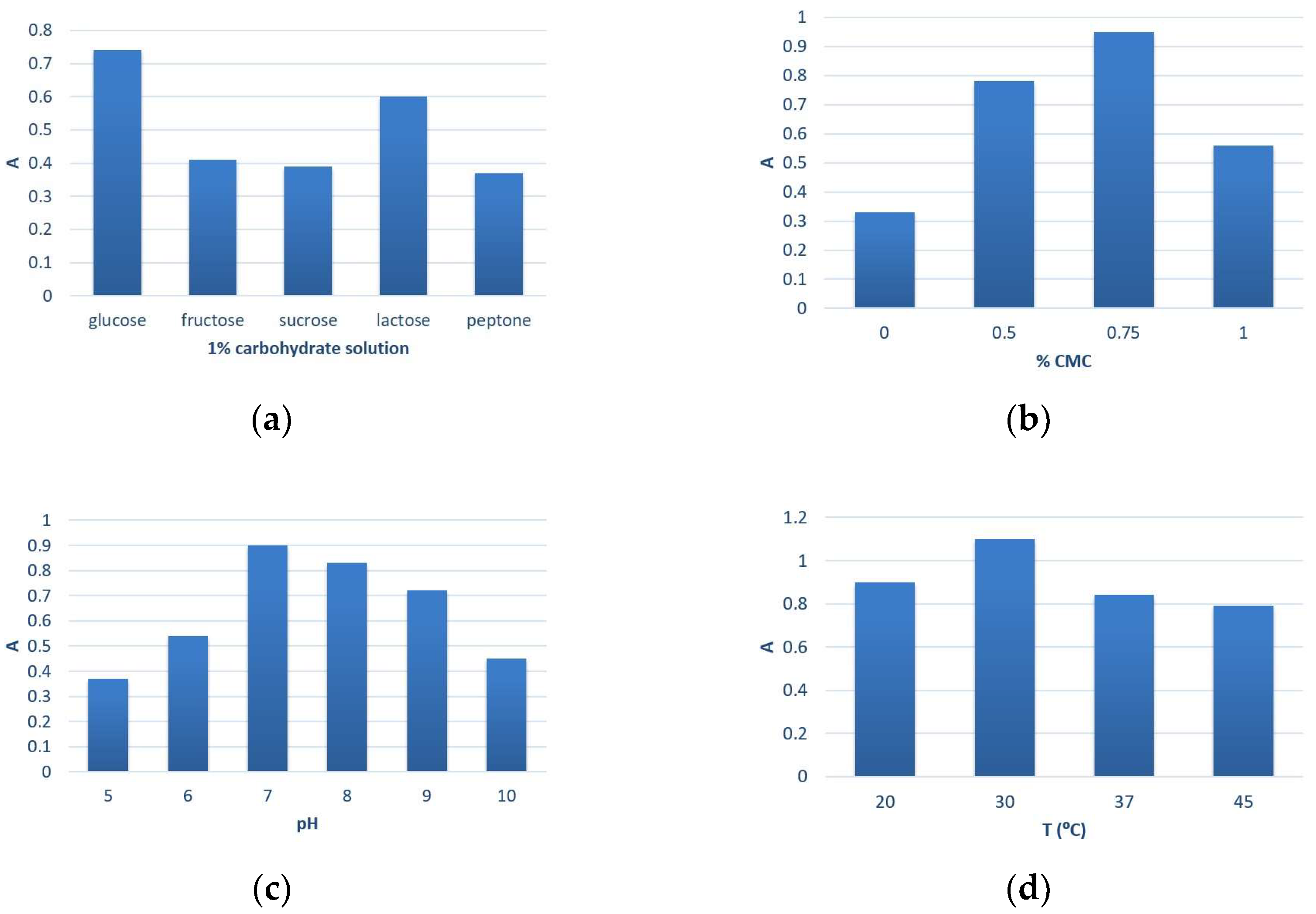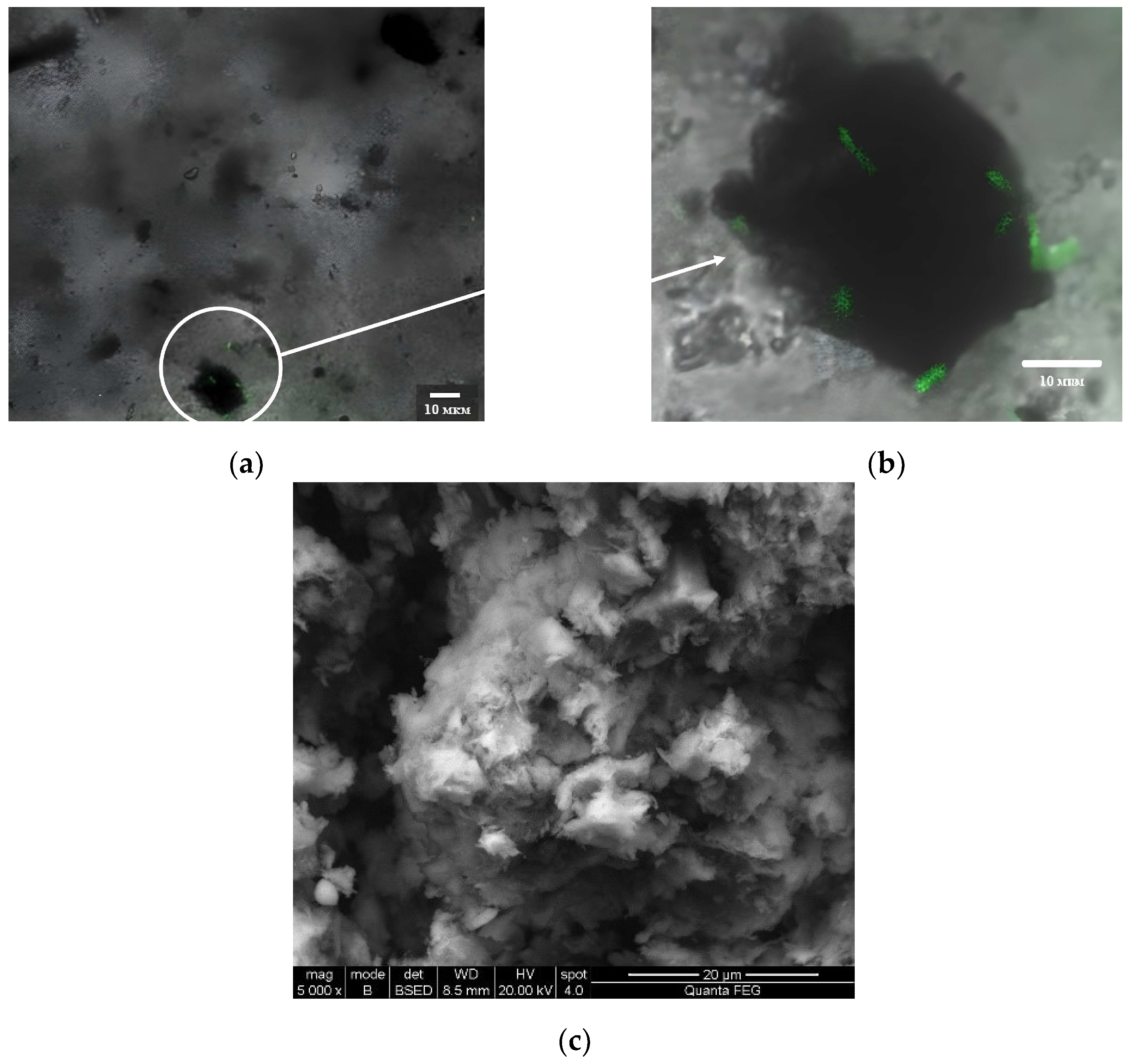1. Introduction
Microorganisms are one of the most important sources of biologically active substances such as proteins, enzymes, antibiotics, and vitamins. When exposed to various stress factors (temperature, drying, oxidizers), new unique properties can appear, from superproduction to the emergence of new protective mechanisms. However, most of them still reduce their biological functions.
It is now known that immobilization and shielding of bacterial cells can increase the safety and viability of microorganisms [
1,
2,
3]. It was previously shown that the immobilization of
Lysobacter sp. on the sodium form of montmorillonite has a beneficial effect on the safety of cells, and an increase in colony-forming units is observed during storage [
4].
The aim of this study was to determine the enzymatic activity of immobilized Lysobacter sp. cells on inorganic matrices.
2. Materials and Methods
Determination of enzymatic (proteolytic) activity: lyophilic culture of
Lysobacter sp. (0.1 g) and biocomposition
Lysobacter sp. on various carriers (0.1 g each, respectively), obtained according to the method described in [
4] in a carrier: biomass ratio of 1:4, were sown on a solid agar medium containing 0.2 wt.% casein and 0.1 wt.% yeast extract. Then, they were incubated for 24 h at T = 30 °C. Afterwards, they were subcultured onto agar slants and incubated under the same conditions.
A 24-h culture on agar slants was suspended in 4 mL of distilled water. Next, 1000 μL of culture liquid was sterilely transferred into previously prepared liquid media with a volume of 100 mL and thermostated at 30 °C for 24 h (until the onset of the logarithmic growth phase).
The proteolytic activity was assessed by the spectrophotometric method using the modified Anson method (Russian Federation State Standard “Enzyme Preparations Methods for Determining Proteolytic Activity”) using a UV/Vis spectrophotometer for studying nano- and microvolumes of liquids (NABI MicroDigital). A 1% aqueous solution of casein was used as a substrate.
To increase the production of β-1,4-glucanase in the nutrient medium for the cultivation of Lysobacter sp., 0.5% sodium carboxymethylcellulose was added and incubated at 37 °C and 150 rpm for 2 days.
To assess enzyme activity, every 12 h, 500 μL of the culture medium was taken and centrifuged at 10,000× g with cooling for 15 min.
The enzymatic activity of β-1,4-glucanase was studied using the method described in [
5].
The optimal temperature for β-1,4-glucanase activity was studied by incubating the enzyme with the substrate in the temperature range of 20–80 °C. The temperature stability of the enzyme was tested by keeping the purified enzyme at various temperatures of 20–80 °C for 1 h, and then adding the substrate to the reaction mixture and incubating at 50 °C. Residual enzyme activity was determined. The sample without the enzyme was used as a control.
The dependence of Lysobacter sp. cell binding to the surface of the sodium form of montmorillonite was studied by confocal microscopy (Digital Eclipse C1 Plus, Nikon, Japan) and scanning electron microscopy using a (Quanta 600 FEG, FEI, Netherlands) scanning electron microscope with an EDX energy-dispersive detector.
3. Results
The results of determining the proteolytic activity of extracellular enzymes of the bacterial culture
Lysobacter sp. are given in
Table 1.
The maximum proteolytic activity of enzymes in the culture liquid of the studied Lysobacter strain is observed at a temperature of 40 °C.
The immobilization of cells on carriers generally has a positive effect on enzyme production and activity. In the case of immobilization on sodium carboxymethylcellulose and the sodium form of montmorillonite, the temperature range of enzymatic activity expands from 35 °C to 45 °C, which will expand the use of biocompositions based on immobilized cells and their enzymes.
The optimal medium for the highest production of β-1,4-glucanase consists of glucose (1%
w/
v), yeast extract (0.2%
w/
v), CMC (0.75%
w/
v), pH 7, inoculum size (3.5% by volume), and the optimal incubation temperature of 30 °C (
Figure 1).
Under optimal conditions, the culture supernatant had an activity of 2.31 U/mL, a specific activity of 1.26 U/mg, a protein content of 1.98 mg/mL, and a total protein content of 990 mg. The culture supernatant was 85% purified. The precipitation of the protein with ammonium sulfate increased the specific activity to 1.37 U/mg. Subsequent purification on a Q-Sepharose ion exchange chromatography column resulted in 8.5-fold purification and a specific activity of 11.5 U/mg. The purified enzyme was active over a wide pH range and had maximum activity at pH 5.5.
Enzyme stability results showed that the enzyme retained 90% of its activity after minimal preincubation at pH 5.5 and more than 60% of maximum activity was retained at pH 4–10, demonstrating tolerance to a wide range of pH.
The optimal temperature for β-1,4-glucanase activity was studied by incubating the enzyme with the substrate in the temperature range of 20–80 °C. The temperature stability of the enzyme was tested by keeping the purified enzyme at various temperatures of 20–80 °C for 1 h, then adding the substrate to the reaction mixture and incubating at 50 °C. The residual enzyme activity was determined. The sample without the enzyme was used as a control.
Figure 2 shows micrographs of a biocomposition based on
Lysobacter sp. bacterial cells shielded by the sodium form of montmorillonite.
Due to the layered structure of montmorillonite type 2:1 and the swelling crystal lattice, which contains water molecules, as well as exchangeable cations Na+, the viability of the microorganism cells is maintained.
Thin nanostructured layered film particles of montmorillonite aggregate on the surface of the bacterial cell wall, thereby protecting it from the effects of UV rays, oxidizers, drying, etc.
4. Conclusions
It was found that the optimal nutrient medium and conditions for the production of β-1,4-glucanase by bacteria Lysobacter sp. consists of glucose (1% w/v), yeast extract (0.2% w/v), CMC (0.75% w/v), pH 7, and an optimal incubation temperature of 30 °C.
The immobilization of cells on carriers generally has a positive effect on enzyme production and activity. In the case of immobilization on sodium carboxymethylcellulose and the sodium form of montmorillonite, the temperature range of enzymatic activity expands from 35 °C to 45 °C, which will expand the use of biocompositions based on immobilized cells and their enzymes.
When cells are immobilized, β-1,4-glucanase activity is maintained over a wide range of pH and temperatures, which expands the possibilities of using compositions under acidic/alkaline conditions and elevated temperatures.
Biocomposites obtained by screening bacterial cells can be used to obtain especially valuable animal feed, biomedical products, and preparations for phytoremediation.








